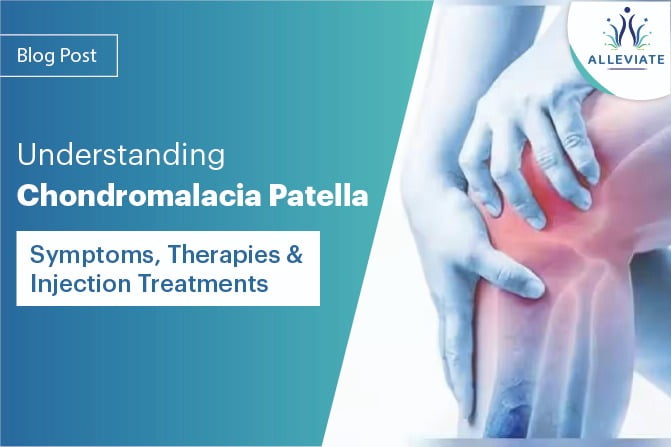Introduction
Chondromalacia patella, a condition often referred to as runner’s knee, is a prevalent source of knee pain, particularly among active individuals. This condition involves the deterioration of the cartilage on the underside of the patella (kneecap), leading to discomfort and potential limitations in mobility. In this comprehensive blog, we’ll explore the intricacies of chondromalacia patella, discussing its symptoms, treatment options, and various therapies available to alleviate pain and restore knee health.
Chondromalacia Patella: An Overview
The patella, a bone that plays a crucial role in knee function, glides smoothly over the knee joint as it moves. However, in cases of chondromalacia patella, the cartilage that covers the back of the patella becomes soft, rough, and damaged. This leads to friction, resulting in pain, inflammation, and discomfort, particularly during activities that involve bending and straightening the knee.
Symptoms of Chondromalacia Patella: Listening to Your Body’s Signals
Recognizing the symptoms of chondromalacia patella is pivotal in seeking timely treatment and pain management strategies. Common symptoms include:
- Knee Pain : Pain around or under the patella is a primary indicator of chondromalacia patella. The pain may worsen when climbing stairs, kneeling, or sitting for prolonged periods.
- Grinding Sensation : Many individuals with chondromalacia patella experience a grinding or clicking sensation when moving their knee. This sensation, known as crepitus, is a result of the roughened cartilage rubbing against the joint.
- Swelling : Inflammation around the patella is common in cases of chondromalacia. Swelling can exacerbate discomfort and limit knee movement.
- Weakness and Instability : Muscle weakness and a feeling of instability in the knee can arise due to altered joint mechanics caused by chondromalacia patella.
Chondromalacia Patella Treatment: A Multifaceted Approach
Effective management of chondromalacia patella involves a combination of treatments tailored to the individual’s condition. The goal is to reduce pain, improve knee function, and prevent further cartilage deterioration. Treatment options include:
Non surgical Therapies used in Chondromalacia Patella
- Physical Therapy : Engaging in targeted exercises can help strengthen the muscles around the knee, improving joint stability and alleviating pain. Quadriceps and hip muscles are often a focus of physical therapy. Therapies play a significant role in managing chondromalacia patella, offering patients non-invasive methods to alleviate pain and improve knee function. Some therapies that have shown promise include:
- Electrotherapy : Techniques like transcutaneous electrical nerve stimulation (TENS) use electrical currents to stimulate nerves and reduce pain perception
- Ultrasound Therapy : By using sound waves to generate heat deep within the tissues, ultrasound therapy can promote blood flow, reduce muscle tension, and alleviate discomfort
- Cryotherapy : Cold therapy, using ice packs or cold compresses, can help reduce inflammation and provide temporary pain relief
- Massage Therapy : Skilled massage therapy can aid in improving blood circulation, reducing muscle tension, and enhancing overall knee function
- Acupuncture : This traditional therapy involves inserting thin needles into specific points of the body. Acupuncture has been reported to help reduce pain associated with chondromalacia patella
- Pain Management : Over-the-counter pain relievers, such as nonsteroidal anti-inflammatory drugs (NSAIDs), can help manage pain and reduce inflammation
- Activity Modification : Temporarily avoiding high-impact activities that exacerbate symptoms can provide the knee with the opportunity to heal and reduce stress on the joint
- Bracing : Patellar braces or straps can help distribute pressure evenly and reduce discomfort during movement
- Injection Therapies : Platelet Rich Plasma (PRP) : PRP is an advanced regenerative therapy that harnesses the body’s own healing abilities. It involves drawing a small amount of the patient’s blood, which is processed by high speed centrifugation to concentrate platelets and growth factors(2,3) and then injecting this enriched plasma into the affected area. These growth factors promote tissue repair, reduce inflammation, and stimulate new tissue growth.
- Prolotherapy : Prolotherapy, or proliferative therapy, is a complementary treatment that involves the injection of natural substances (often dextrose or saline) into weakened or injured ligaments or tendons. These injections provoke a localized inflammatory response, which activates the body’s natural healing processes, leading to tissue repair and strengthening(4-7)
- Viscosupplementation– Injections of hyaluronic acid are seen to help in lubrication and alleviating the symptoms of Chondromalacia Patella.
AT ALLEVIATE, we use a combination proliferating regenerative injection technique combining the benefits or Platelet Rich Plasma, Prolotherapy and Viscosupplementation Along with a structured physical therapy protocol.
- Surgical Interventions : In severe cases where conservative methods do not provide relief, surgical procedures like arthroscopy may be considered to address cartilage damage
Empowering Yourself for Optimal Knee Health
Chondromalacia patella, while challenging, can be managed effectively through a combination of treatments and therapies. Recognizing the symptoms and understanding your body’s signals is the first step toward seeking appropriate medical guidance. With the right approach, you can take control of your knee health, alleviate pain, and embark on a journey toward improved mobility and quality of life.
References
- Habusta SF, Coffey R, Ponnarasu S, et al. Chondromalacia Patella. [Updated 2023 Apr 22]. In: StatPearls [Internet]. Treasure Island (FL): StatPearls Publishing; 2023 Jan-. Available from: https://www.ncbi.nlm.nih.gov/books/NBK459195/
- Kon E, Filardo G. PRP or not PRP?! That is the question. Knee Surg Sports Traumatol Arthrosc. 2011;19(6):870-1.
- Nguyen RT, Borg-Stein J, McInnis K. Applications of platelet-rich plasma in musculoskeletal and sports medicine: an evidence-based approach. PM R. 2011;3(3):226-50.
- Akpancar S, Seven MM, Tuzun HY, et al. Current concepts of prolotherapy in orthopedic surgery. Arch Trauma Res. 2017;6(2):e40447.
- Martins CAQ, Bertuzzi RT, Tisot RA, et al. Dextrose prolotherapy and corticosteroid injection into rat Achilles tendon. Knee Surg Sports Traumatol Arthrosc. 2012;20(10):1895-900.
- Rabago D, Lee KS, Ryan M, et al. Hypertonic dextrose and morrhuate sodium injections (prolotherapy) for lateral epicondylosis (tennis elbow): results of a single-blind, pilot-level, randomized controlled trial. Am J Phys Med Rehabil. 2013;92(7):587-96.
- Seven MM, Ersen O, Akpancar S, et al. Effectiveness of prolotherapy in the treatment of chronic rotator cuff lesions. Orthop Traumatol Surg Res. 2017;103(3):427-33.




